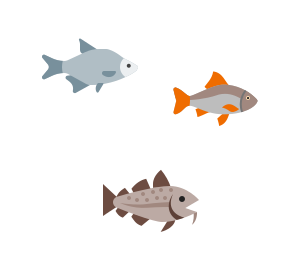
| 60 kg headless grouper, fresh or frozen3 kg headless grouper, fresh or frozen, (5 portions of your choice) | |
| 2 ½-3 kg of oil1/2 teacup of oil | |
| 10 kg of whole onions8 medium onions, whole | |
| 3 water glasses of garlic, whole cloves10 garlic cloves, whole cloves | |
| 500 g large celery stems5 medium celery stems | |
| handful of salt, finefine salt | |
| 1 wine cup of ground pepper10 grains of green or black pepper | |
| 1 ½ kg natural lemon juice1 coffee cup of natural lemon juice | |
| water (as needed)water (as needed) | |
| 300 g finely chopped parsley, for garnish1 cup of finely chopped brown parsley, for garnish |
| 1. | Preparation: |
| 2. | The Grouper (required quantity) can be from one to several fish. |
| 3. | Several hours before cooking (even the day before), prepare the fish. |
| 4. | If they are in the freezer, take them out in time for them to defrost. |
| 5. | Clean the fish of their skin, rinse them a little to remove any stuck on them and then open the belly lengthwise and clean the giblets and gills. |
| 6. | The tireless cook will also remove the black membrane that the fish have on the inner walls of their belly, mainly for reasons of hospitality and to avoid visual displeasure of the fellow diners! |
| 7. | Be careful not to throw away their eggs (if they have any), nor their livers. Keep them and use them in soup or fry them in combination with another food. |
| 8. | Then, if they have them, cut off the head and fins and keep them in the freezer for soup. |
| 9. | Now we have a headless fish. With a sharp knife, cut portions (pieces) of the same thickness all over the surface of the fish. The back part of the fish, the tail, is marked in a much thicker thickness because it is thinner, to ensure a portion. The next one is a little narrower so that you get a regular portion. When the fish starts to get thick (coarse), then we cut it to a certain 3-point thickness, regardless of whether each piece is more than a portion. |
| 10. | Then, with a larger suitable knife, cut the pieces you have cut to the end. |
| 11. | If the pieces have a large width, cut them into two or three portions. |
| 12. | Remove the blood and the black membrane, if any, from the inside of the belly in each portion. |
| 13. | After cutting and cleaning, wash all the pieces very well and place them in a strainer to drain the water. |
| 14. | When all the water is gone, in another strainer we make layers-layers-layers-salting each layer with the coarse salt. |
| 15. | The salt doesn't need to be skimped on because we will scrape the salt off before cooking. |
| 16. | Cover the pan and place it in the refrigerator until ready to cook. |
| 17. | It must be left in the salt for at least 5 hours. |
| 18. | Onion juice: |
| 19. | Several hours before cooking (even the day before), prepare the onion juice. |
| 20. | Put all the onions (except for the three large ones) cut into three pieces in a suitable container, along with a little salt and 50 g of oil. |
| 21. | Pour water until they are very well covered, 7 inches above them, and put them on the fire to boil. |
| 22. | Let them boil for about an hour, stirring periodically. |
| 23. | When they boil, their water should be almost half full. |
| 24. | Once they have cooled down, pour a few of them into a large hole strainer that you have in a bowl to collect the juice. |
| 25. | Stir very well, until at least half the amount of the melted mixture remains in the hole. |
| 26. | Then pour the rest of the crushed onions into another bowl. |
| 27. | Add a little water, just enough to dilute the material and mix very well to extract the juices. |
| 28. | Pour the mixture back into the strainer and repeat the same process until they are completely drained. |
| 29. | Then discard the rest of the onion mixture and keep the drained juice. |
| 30. | Boiling: |
| 31. | When it is time to cook, rinse the salted portions lightly. |
| 32. | If necessary, leave the portions in water for a few hours to dry out the excess salt. |
| 33. | Care should be taken that the portions are not completely salty but somewhat salty, so that you don't have to salt them again in the dava. |
| 34. | To understand that they are really unsalted, try a few pieces with your tongue, from different points on the cut (inner) part and not on the skin. |
| 35. | After skimming, drain the pieces in a colander and leave them in the refrigerator until ready to cook. |
| 36. | We take a suitable dava depending on the amount of food. |
| 37. | Lay out the portions (pieces) of the grouper, each piece next to the other, so that they all fit in the dava. |
| 38. | Place the portions in such a way that one rests on the back of the other and in a circular manner, starting from the periphery towards the centre of the dava. |
| 39. | Place a few celery in the centre of the dava and place the 3 large whole onions on top of them. This is because there is a lot of heat in the centre so that the onions can absorb it and not destroy some portions of fish. |
| 40. | If some pieces don't fit, throw them on top as a second layer, no problem. |
| 41. | Add the onion juice until the fish is well covered and has 4 inches of onion juice on top. |
| 42. | If we have experience the juice will be just right for us. Add a little water if necessary. If we have leftover, we keep it in the freezer for another use. |
| 43. | Cover the dava and put it on the fire. |
| 44. | After about 15 minutes it starts to boil. |
| 45. | Once the dirt starts to come out, skim it with a flat-bladed slotted spoon and discard it. |
| 46. | When the foam has been removed, pour the garlic, celery and oil into the dava and over the fish and cover to boil. |
| 47. | You need to be careful with the amount of oil because too much oil will make it taste greasy, but mostly it will dry it out and will not help the sauce to thicken. |
| 48. | At regular intervals, move the dava to the right and left to prevent the fish from getting stuck and watch it closely. |
| 49. | After 40 minutes, we should probably remove the dava lid completely because it will stick. |
| 50. | It takes a maximum of 1 hour to boil. |
| 51. | Towards the end of the boiling, the fire should be less and the movements to the right and left of the dava are necessary to prevent the portions from sticking. |
| 52. | Check the amount of stock to be served and if it is not enough, add a little water. |
| 53. | Now adjust the salt, if necessary, by tasting the stock. |
| 54. | In practice you should see the portions of fish almost covered. |
| 55. | Five minutes before removing the dava from the heat, pour the lemon juice over the surface of the fish. |
| 56. | Shake vigorously until the lemon and fish juices are combined and remove from the heat. |
| 57. | Do not cover the dava until it has cooled down a little. |
| 58. | When serving, sprinkle some parsley on top. |
| 59. | It is served and eaten hot. |
| 60. | Tip: |
| 61. | We always add more kilos of fish because some portions may be ruined during cooking or serving, so it's good to have planned ahead. |
| 62. | The proportion in each portion should be rich, around 200 grams each, because there is no accompaniment , e.g. potatoes, pumpkins or carrots etc.. |
| 63. | Be careful because of the juices of the fish and the onion, it sticks very easily, so keep a close eye on it throughout the boiling process. |
| 64. | Be careful not to put wood (do not increase the heat) in between the boiling, it is best to fill the masina from the beginning so that the boiling is not interrupted and towards the end the power of the masina is steadily lowered. |
| 65. | When the fish is cooked we see it literally dancing in the dava and if we blink our hand over the steam we find that it sticks. |
| 66. | Instead of lemon, you can use tomato paste with a little sour, dissolved in a little water or fish stock. In this case, allow more time for the sauce to unify by adding the sauce earlier. The taste in both options is equally wonderful. |
| 67. | The "Mount Athos" Grouper is one of the most beautiful monastic Athonite dishes. It is common in the winter season because it has a lot of fat, in the summer it is a bit heavy on the health. |
